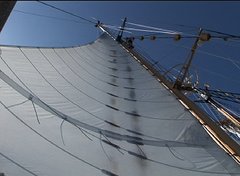 |
| Curious Minke whale from aloft (Hanna Payne) |
The questions, indeed this whole encounter, took me back to the Hopkins Marine Station where we started our voyage. During those frantically busy five weeks, the students learned a great deal about the ocean they would be studying; its currents, chemistry and plankton inhabiting the deep. But probably more importantly, a series of Friday conservation lectures challenged them to think deeply about our relationship with the ocean and all the fantastic life in it. Our close encounter with the whales could have come straight out of the very first lecture, given by Carl Safina, a noted author and leader in ocean conservation. In a moving talk grounded in science and much research, he challenged us to re-think our relationship with animals, to re-examine our assumptions about their consciousness and intellect.
In another talk in the series, Doug McCauley from UC Santa Barbara rang the alarm bell about the creeping industrialization of the oceans while Mark Meekan from Australian Institute of Marine Science gave us front-row look at the depletion of shark populations globally, and strategies for their conservation. Jeremy Jackson, at Scripps Institution of Oceanography, spoke of the challenges to coral reefs and the need to understand the socioeconomic drivers behind destructive human behaviors in exploiting the reefs, while Nancy Knowlton of the Smithsonian Institution told us to recognize and celebrate the success stories in marine conservation when we see them in action.
These themes have come up and again during our voyage. We’ve seen, measured, photographed and videoed sharks, and reefs, parrotfish, and strange deep-water plankton, ocean productivity, and hotspots of ocean life. Throughout the work of the cruise, the concerns and the challenges given to us by the speakers at Hopkins have kept bubbling up, and I figure for these young minds they will continue to do so.
Something different yet equally powerful the voyage has given us all is a new, or renewed, love affair with the ocean. The wonder of the starlit skies on the open ocean, the rush of bubbles and cool embrace of the water of a swim call, the colors and shapes of the reef corals and fish There is much to love, we all have our favorite moments. The best thing is that all these visceral experiences couple powerfully with the intellect, with our concerns for the future of our ocean.
 |
| Stanford@SEA 2017 in Pago Pago |
At anchor, Pago Pago Harbor,
-Jan Witting,
SEA Chief Scientist.
Lastly, a post script and shout out to the soul of Stanford @ Sea. This expedition -- specifically for Stanford students, like the others before it -- would not have been possible without Barb Block. Unfortunately, she was not able to take her place on the ship due to family medical emergency. Barb’s passion for the ocean brought this program into being. During our five weeks at Hopkins she worked her magic on this class as well. We missed you Barb, but I think you’d be proud of what this class has done and has become!


No comments:
Post a Comment